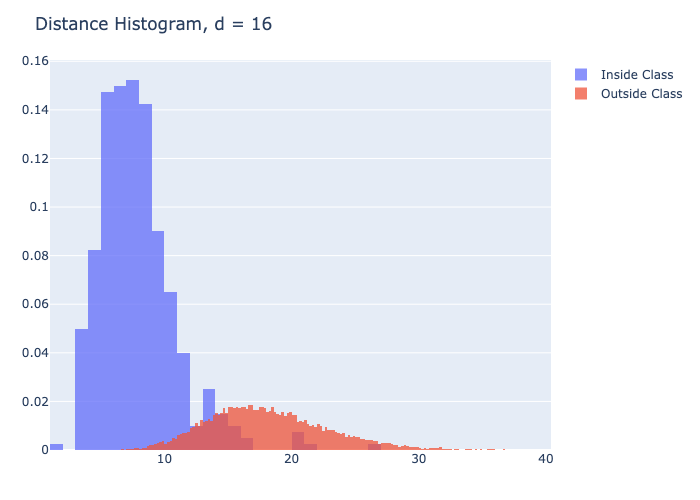I have $1200$ face images in my training set. There are $2989$ test face images. I am using eigenfaces (PCA) for feature extraction and $k$-means clustering. I even tried all $2989$ test face images as training set images, but no accuracy is achieved.
Source code i tried:
tic
clear all
close all
clc
% number of images on your training set.
M=100;
% Chosen std and mean.
% It can be any number that it is close to the std and mean of most of the images.
um=60;
ustd=32;
% read and show images(bmp);
S=[]; %img matrix
for i=1:M
str=strcat(int2str(i),'.jpg'); %concatenates two strings that form the name of the image
eval('img=imread(str);');
[irow icol d]=size(img); % get the number of rows (N1) and columns (N2)
temp=reshape(permute(img,[2,1,3]),[irow*icol,d]); %creates a (N1*N2)x1 matrix
S=[S temp]; %X is a N1*N2xM matrix after finishing the sequence
%this is our S
end
% Here we change the mean and std of all images. We normalize all images.
% This is done to reduce the error due to lighting conditions.
for i=1:size(S,2)
temp=double(S(:,i));
m=mean(temp);
st=std(temp);
S(:,i)=(temp-m)*ustd/st+um;
end
% show normalized images
for i=1:M
str=strcat(int2str(i),'.jpg');
img=reshape(S(:,i),icol,irow);
img=img';
end
% mean image;
m=mean(S,2); %obtains the mean of each row instead of each column
tmimg=uint8(m); %converts to unsigned 8-bit integer. Values range from 0 to 255
img=reshape(tmimg,icol,irow); %takes the N1*N2x1 vector and creates a N2xN1 matrix
img=img'; %creates a N1xN2 matrix by transposing the image.
% Change image for manipulation
dbx=[]; % A matrix
for i=1:M
temp=double(S(:,i));
dbx=[dbx temp];
end
% Covariance matrix C=A'A, L=AA'
A=dbx';
L=A*A';
% vv are the eigenvector for L
% dd are the eigenvalue for both L=dbx'*dbx and C=dbx*dbx';
[vv dd]=eig(L);
% Sort and eliminate those whose eigenvalue is zero
v=[];
d=[];
for i=1:size(vv,2)
if(dd(i,i)>1e-4)
v=[v vv(:,i)];
d=[d dd(i,i)];
end
end
% sort, will return an ascending sequence
[B index]=sort(d);
ind=zeros(size(index));
dtemp=zeros(size(index));
vtemp=zeros(size(v));
len=length(index);
for i=1:len
dtemp(i)=B(len+1-i);
ind(i)=len+1-index(i);
vtemp(:,ind(i))=v(:,i);
end
d=dtemp;
v=vtemp;
% Normalization of eigenvectors
for i=1:size(v,2) %access each column
kk=v(:,i);
temp=sqrt(sum(kk.^2));
v(:,i)=v(:,i)./temp;
end
% Eigenvectors of C matrix
u=[];
for i=1:size(v,2)
temp=sqrt(d(i));
u=[u (dbx*v(:,i))./temp];
end
% Normalization of eigenvectors
for i=1:size(u,2)
kk=u(:,i);
temp=sqrt(sum(kk.^2));
u(:,i)=u(:,i)./temp;
end
% show eigenfaces;
for i=1:size(u,2)
img=reshape(u(:,i),icol,irow);
img=img';
img=histeq(img,255);
end
% Find the weight of each face in the training set.
omega = [];
for h=1:size(dbx,2)
WW=[];
for i=1:size(u,2)
t = u(:,i)';
WeightOfImage = dot(t,dbx(:,h)');
WW = [WW; WeightOfImage];
end
omega = [omega WW];
end
toc
tic
% Acquire new image
% Note: the input image must have a bmp or jpg extension.
% It should have the same size as the ones in your training set.
% It should be placed on your desktop
ed_min=[];
srcFiles = dir('F:\mat2012 instaled\bin\database\100 trainingset\test\*.jpg'); % the folder in which ur images exists
for b = 1 : length(srcFiles)
filename = strcat('F:\mat2012 instaled\bin\database\100 trainingset\test\',srcFiles(b).name);
Imgdata = imread(filename);
%figure, imshow(Imgdata);
InputImage=Imgdata;
InImage=reshape(permute((double(InputImage)),[2,1,3]),[irow*icol,1]);
temp=InImage;
me=mean(temp);
st=std(temp);
temp=(temp-me)*ustd/st+um;
NormImage = temp;
Difference = temp-m;
p = [];
aa=size(u,2);
for i = 1:aa
pare = dot(NormImage,u(:,i));
p = [p; pare];
end
InImWeight = [];
for i=1:size(u,2)
t = u(:,i)';
WeightOfInputImage = dot(t,Difference');
InImWeight = [InImWeight; WeightOfInputImage];
end
noe=numel(InImWeight);
z(b,:)=InImWeight;
end
IDX = kmeans(z,5)
clustercount=accumarray(IDX, ones(size(IDX)));
%disp(clustercount);
toc
5 different faces are shown below.

Unfortunately, images are not clustered properly. Same faces should be clustered, but different faces are being clustered.
Should I have to use still more face images for training?
How can accurate clustering be achieved? What is the solution?



